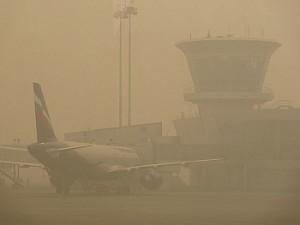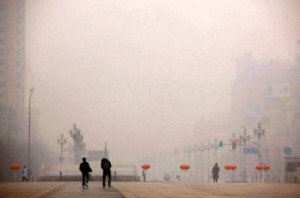
If wishes were horses, travelers would have a whole herd of sunny blue skies greeting them wherever they went. Unfortunately, in today’s industrialized society that is not always possible. Air pollution, whether man-made in factories or nature-made by forest fires, is a fact of life.
Air pollution is hazardous to one’s health, especially for people who suffer from respiratory ailments. Just because a person has respiratory problems, however, doesn’t mean he can only be an armchair traveler. With proper precautions, a person with asthma or chronic obstructive pulmonary disease (COPD) should be able to travel almost anywhere he wants to go. Such travelers may want to avoid developing countries, especially in Asia and the Middle East, since the World Health Organization (WHO) ranks them among the most polluted in the world due to their new industrialization. Travelers who want to check air pollution levels at their intended destination can consult a database. WHO maintains data on all countries and 1,100 cities around the world.
Protecting Yourself Against Air Pollution
A good protection plan begins before a traveler leaves home. Travelers with respiratory problems, who are elderly or suffer from chronic conditions such as diabetes may want to start with recommendations from their health care providers, who may prescribe extra inhalers, antibiotics or oral steroids. Travelers should take along a copy of any prescriptions in case they need a refill while traveling or customs and immigration officials ask about those pill bottles at border crossings. This is something all travelers on medications should do anyway.

All travelers may want to tuck some disposable face (surgical) masks in their luggage. They’re inexpensive and don’t take up much room. While the masks won’t turn dirty air into clean air, they provide protection from airborne particles reaching your lungs.
The American Lung Association offers tips to protect yourself against air pollution, some of which can apply to travelers. The organization recommends motorists fill gas tanks only after dark because the sun turns evaporating gasoline emissions into air pollution. When air pollution levels are high, avoid outdoor exercises, such as jogging, as your lungs require more oxygen. If you must exercise outside, do it in the early morning hours when pollution is at its lowest. Pay attention to air pollution levels by monitoring news broadcasts or the U.S. Environmental Protection Agency’s air quality website. Travelers abroad may also find this information by checking for health alerts on their embassy’s website.
If air pollution is too high, travelers may want to curtail outdoor activities or limit them to early morning hours. When air pollution reaches dangerously high levels, such as happened at Beijing in early 2013, travelers may want to go somewhere else. If travelers are locked into a package tour, they should ask the tour company what their options are. If air pollution crops up suddenly, such as a major forest fire with winds sending smoke hundreds of miles away, travelers may want to consider leaving if the smoke is too much to bear.

Know When to Go
Knowing when to travel to some countries is an important consideration. A savvy traveler does his homework on this issue. Take China, for instance. China has lots of air pollution, but it may surprise travelers to learn that no Chinese city is on WHO’s top 10 list of the most polluted cities in the world, while four cities in Iran made this list. However, more people will travel to China than Iran. In China’s largest industrialized cities, air pollution is pretty much an inevitability. Travelers may want to avoid northeast China in the winter when burning coal for heat adds to already polluted skies. Factories shut down for a week or two around major holidays, such as Chinese New Year, May Day and National Day, so the air is cleaner and skies are bluer, making these better times to visit. Unfortunately, this means travelers will be fighting for space for transportation and accommodations, and at attractions with hundreds of millions of Chinese who will be traveling at the same time.

In some areas around the world, smog is worst in the summer when the weather is hot and humid. Travelers with asthma or allergies may want to avoid destinations when pollen levels are at their highest.
Symptoms of Air Pollution
Air pollution can cause serious health problems, especially when the pollution is at high levels over a long period of time. According to the International Association of Medical Assistance to Travelers, travelers’ health suffers from symptoms including wheezing, coughing, headaches, nausea, upper respiratory infections such as bronchitis and pneumonia, and itchy eyes, nose and throat, all due to air pollution. The association recommends older travelers have physical examinations before traveling to polluted destinations while other travelers should leave newborns and young children at home.
Traveling to areas that suffer from air pollution can be done, but such travel takes more planning than visiting a destination where the skies are perpetually blue. Travelers to polluted areas shouldn’t count on clear skies. They may get lucky and a good wind will come along to blow the smog away!

